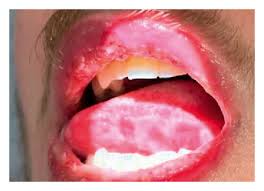 Reactive infectious mucocutaneous eruption (RIME) is a relatively uncommon mucocutaneous condition resulting from Mycoplasma pneumoniae infection.
Reactive infectious mucocutaneous eruption (RIME) is a relatively uncommon mucocutaneous condition resulting from Mycoplasma pneumoniae infection.
It is less commonly due to other viral and bacterial infections.
It is characterized by prominent mucositis.
It is usually seen in children and adolescents with mean age of approximately 12 years.
Adults of middle age and younger individuals may also be affected.
RIME occurs more commonly in males than females (ratio of 2:1).
The symptoms of cough, fever, and malaise precede mucocutaneous manifestations by approximately a week.
Mucositis is a prominent feature.
Complications of RIME may include: hematemesis, epiglottitis, subcorneal pustulosis, pneumomediastinum, pericardial effusion, hepatitis, conjunctival shrinkage, corneal ulceration, blindness, synechiae, dry eyes, and loss of eyelashes, oral or urogenital adhesions,
are less common, restrictive lung disease and chronic obliterative bronchitis.
It is very rarely fatal and has a reported mortality rate of 3%, occurring in cases with significant respiratory disease.
Most patients have a full recovery, and both long-term complications and recurrences are infrequent.
Pathophysiology: cytotoxic injury, autoimmune-mediated injury, and immune complex-mediated vascular injury have all been proposed as potential etiological mechanisms.
It is speculated that a genetic predisposition is likely.
Autoantibodies are suspected to be produced as a result of molecular mimicry between M pneumoniae and endogenous proteins cross-react with specific self-antigens that are most abundant in mucous membranes.
